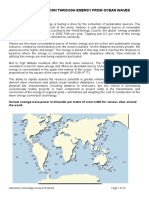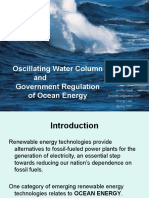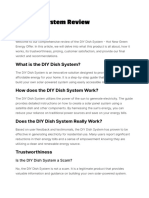Cierhan
Cierhan
Uploaded by
SamCopyright:
Available Formats
Cierhan
Cierhan
Uploaded by
SamOriginal Description:
Copyright
Available Formats
Share this document
Did you find this document useful?
Is this content inappropriate?
Copyright:
Available Formats
Cierhan
Cierhan
Uploaded by
SamCopyright:
Available Formats
Introduction
The main aims of this report were to research wave power and then produce a
feasibility report that could be presented to the small town of 5000 households,
that the project would affect. In this report we will look at what wave power is,
the technology used and the social and environmental impact it can have. We
will then present our recommendations for what action the town should take with
this project.
Technology
Oscillating Water Column is a partially submerged, hollow structure. It is open to
the sea below the water line, enclosing a column of air on top of a column of
water. Waves cause the water column to rise and fall, which in turn compresses
and decompresses the air column. This trapped air is allowed to flow to and from
the atmosphere via a turbine, which usually has the ability to rotate regardless of
the direction of the airflow. The rotation of the turbine is used to generate
electricity.
Location
These power plants can be placed in 1 of 4 locations. Shore line, Near-shore,
Breakwater or Off-shore.
Shore line devices are found right on the edge of the land. Depending on the size
and volumes of the waves, these power plants can produce anything from a few
hundred kilowatts up to a few megawatts of power.
Near-shore devices are placed a couple of hundred meters away from the coast
in approximately 10-25 meter deep water. They are connected to the mainland
via a dam. Depending on the wave size and the size of the plant itself, it can
produce between 10-100 megawatts of power. Such power plants can already be
operated economically due to the UKs feed-in tariffs. These power plants can
also be used as docks for small ships and boats.
Breakwater power plants are between Shore Line and Near-shore. This system
integrates the power plant with a new build coastal structure, such as a harbour
breakwater or coastal protection project. This can significantly reduce the costs
of building each structure separately. Depending on the location, more than 10
MW can be achieved by these power plants.
Off-shore devices are situated in deep water, about 40 meters deep. These
systems are usually the most difficult to build and most expensive too. However,
the bigger waves found further from the shore can give higher power output.
You might also like
- Past Exams Matrix and Solns 1516Document35 pagesPast Exams Matrix and Solns 1516Sam100% (2)
- Seminar Report On Ocean Wave EnergyDocument23 pagesSeminar Report On Ocean Wave EnergySushobhan Das86% (7)
- Past Exams Tors Vibs and Solns 1516Document20 pagesPast Exams Tors Vibs and Solns 1516SamNo ratings yet
- Past Exams Lefm and Solns 1516Document35 pagesPast Exams Lefm and Solns 1516SamNo ratings yet
- Continuous Assessment 1-HandoutDocument3 pagesContinuous Assessment 1-HandoutSamNo ratings yet
- Wave Energy SlidesDocument27 pagesWave Energy SlidesAziela Amin100% (1)
- HydroDocument18 pagesHydroali.ahsanNo ratings yet
- Tidal Power, Ocean Thermal Energy, & Geothermal Energy ConversionDocument10 pagesTidal Power, Ocean Thermal Energy, & Geothermal Energy ConversionMohammed AnsafNo ratings yet
- Report Submitted ON: Submitted By: Pooja Malik ROLL NO: 0804034 Branch: Mechanical (4 Year)Document25 pagesReport Submitted ON: Submitted By: Pooja Malik ROLL NO: 0804034 Branch: Mechanical (4 Year)malik_poojaNo ratings yet
- Wave EnergyDocument2 pagesWave EnergyAswin Kurnia RamadhanNo ratings yet
- Energy From Ocean and Tides: S. SridharDocument123 pagesEnergy From Ocean and Tides: S. SridharPurna Chander Chandu100% (1)
- Tidal EnergynewDocument34 pagesTidal EnergynewLalit GargNo ratings yet
- Presented By:: Said Mohamed NazimDocument7 pagesPresented By:: Said Mohamed NazimSchmetterling TraurigNo ratings yet
- Seminar Report On Under Water Turbines by NithunDocument23 pagesSeminar Report On Under Water Turbines by NithunHasir Chelat82% (11)
- Technical Seminar Report OnDocument10 pagesTechnical Seminar Report OnkrishnaNo ratings yet
- Pelamis Wave Energy Converter (Le202)Document26 pagesPelamis Wave Energy Converter (Le202)Dasari Ramamohana0% (1)
- Desai Harshad Suresh B050254EEDocument37 pagesDesai Harshad Suresh B050254EEvikkyymsnbNo ratings yet
- Oscillating Water Column and Government Regulation of Ocean EnergyDocument48 pagesOscillating Water Column and Government Regulation of Ocean EnergyimamrohaniNo ratings yet
- Ocean EnergyDocument28 pagesOcean EnergyBhagatsinh GedaNo ratings yet
- RER Unit 2 Concise Notes Sidarth SirDocument21 pagesRER Unit 2 Concise Notes Sidarth Sirgociy20905No ratings yet
- Quote by John Kabat Zinn: ConfidentlyDocument3 pagesQuote by John Kabat Zinn: ConfidentlyBiba JacksonNo ratings yet
- FloatingDocument6 pagesFloatingkommerapranayreddyNo ratings yet
- Wave EnergyDocument4 pagesWave Energyjohnny dolNo ratings yet
- Under Water Wind Mill ReportDocument13 pagesUnder Water Wind Mill ReportASHUTOSH SAHOOLME011 (LME011)No ratings yet
- Tidal Energy: Aanchal Gupta 1RV07EC001Document39 pagesTidal Energy: Aanchal Gupta 1RV07EC001aanchalg20No ratings yet
- Physics Tidal EnergyDocument29 pagesPhysics Tidal EnergySrinivasa RNo ratings yet
- Technical Seminar Topic: Bachelor of Technology Electrical and Electronics EngineeringDocument24 pagesTechnical Seminar Topic: Bachelor of Technology Electrical and Electronics EngineeringmaneeshNo ratings yet
- Wave Energy - PradhanDocument45 pagesWave Energy - PradhannitinrnnnNo ratings yet
- Documentation of Technical SeminarDocument25 pagesDocumentation of Technical SeminarmaneeshNo ratings yet
- Wave Power: Presented By: Group - IvDocument16 pagesWave Power: Presented By: Group - IvKIRAN GOPAL100% (1)
- WaveenergyscanDocument14 pagesWaveenergyscanChersey DoctorNo ratings yet
- Wave EnergyDocument6 pagesWave EnergyRuhi ShaikNo ratings yet
- Prospects of Electricity From Tidal Power in Coastal Regions of BangladeshDocument10 pagesProspects of Electricity From Tidal Power in Coastal Regions of BangladeshAnonymous C9ZNFkrb6No ratings yet
- Wolff Energy Law PresentationDocument48 pagesWolff Energy Law Presentationhendri cahyadiNo ratings yet
- TidalDocument18 pagesTidalvijaysailsNo ratings yet
- DougieDocument1 pageDougieSamNo ratings yet
- Chapter-I: Department of EEE, Adam's College, PalonchaDocument17 pagesChapter-I: Department of EEE, Adam's College, PalonchapraneethNo ratings yet
- Multi Function Wave Energy DevicesDocument23 pagesMulti Function Wave Energy DevicesPrashant BhardwajNo ratings yet
- Seminar .Hari MainDocument28 pagesSeminar .Hari Maink8739548No ratings yet
- Tidal Energy: Student Name: Akhil Alle Student Number: W19049340 Module Code: Kd7068Document18 pagesTidal Energy: Student Name: Akhil Alle Student Number: W19049340 Module Code: Kd7068Mah EshNo ratings yet
- 13-Tidal and Wave-26-09-2024Document29 pages13-Tidal and Wave-26-09-2024pankhurikapoorrNo ratings yet
- Document Floating Power StatonDocument7 pagesDocument Floating Power Statonajay kumar royNo ratings yet
- RES Unit V-MISCELLANEOUS ENERGY TECHNOLOGIESDocument126 pagesRES Unit V-MISCELLANEOUS ENERGY TECHNOLOGIESbhuvanachandra54No ratings yet
- Whittaker 2011Document20 pagesWhittaker 2011cefer86No ratings yet
- Meen 669 HW23Document5 pagesMeen 669 HW23uchnnaNo ratings yet
- Tidal Power The Future Wave of Power Generation: K.Kesava ReddyDocument14 pagesTidal Power The Future Wave of Power Generation: K.Kesava ReddytslnarayanaNo ratings yet
- Wave Tidal PowerDocument39 pagesWave Tidal PowerSalihah AbdullahNo ratings yet
- Tidal Energy Which Is Clean, Green&Sustainable Energy: AbstractDocument26 pagesTidal Energy Which Is Clean, Green&Sustainable Energy: Abstractajay_kairiNo ratings yet
- Tidal EnergyDocument19 pagesTidal Energyapi-512045647No ratings yet
- Power Plant Engineering UNIT-4Document7 pagesPower Plant Engineering UNIT-4MuskanNo ratings yet
- Floating Windmills: D C Chaarshani (B.E.), S Yamuna (B.E)Document7 pagesFloating Windmills: D C Chaarshani (B.E.), S Yamuna (B.E)AkashNo ratings yet
- Working Paper - Tidal Energy and OTEC - Batilo JMGDocument19 pagesWorking Paper - Tidal Energy and OTEC - Batilo JMGJan Michael BatiloNo ratings yet
- Tidal3 PDFDocument3 pagesTidal3 PDFAlexander WijesooriyaNo ratings yet
- What Is Wave Energy A Complete GuideDocument10 pagesWhat Is Wave Energy A Complete GuideYassine Alami TahiriNo ratings yet
- Ret TidalenergyDocument21 pagesRet TidalenergySaralita NairNo ratings yet
- WindfarmsDocument9 pagesWindfarmsMohamed EssamNo ratings yet
- C CC C CC C CCCCCCCC CCCCCCCCCCCCCC CCCCCCCCCCC C C CCCCC CCCC C CCC CCC CC CCCCC C CCCCC CCC CCCCCCCCCCC CCCCC CC CDocument12 pagesC CC C CC C CCCCCCCC CCCCCCCCCCCCCC CCCCCCCCCCC C C CCCCC CCCC C CCC CCC CC CCCCC C CCCCC CCC CCCCCCCCCCC CCCCC CC CVale Shyamkumar0% (1)
- Underwater Windmill Seminar ReportDocument37 pagesUnderwater Windmill Seminar ReportPappu Mala33% (3)
- Under Water WindmillDocument23 pagesUnder Water Windmillapi-343773957100% (2)
- Jal-Chakra: Tidal Power Plant: Tackling Power Crisis in IndiaDocument9 pagesJal-Chakra: Tidal Power Plant: Tackling Power Crisis in IndiaDivya GoyalNo ratings yet
- Tidal RVWRDocument7 pagesTidal RVWRcatherinejeanasNo ratings yet
- Hydro Power PlantDocument22 pagesHydro Power PlantSiti ZhakiyahNo ratings yet
- Coursework Cover Sheet: School of Engineering and Built EnvironmentDocument1 pageCoursework Cover Sheet: School of Engineering and Built EnvironmentSamNo ratings yet
- CostaDocument1 pageCostaSamNo ratings yet
- DougieDocument1 pageDougieSamNo ratings yet
- Continuous Assessment 2Document2 pagesContinuous Assessment 2SamNo ratings yet
- Metrology Lab ReportDocument4 pagesMetrology Lab ReportSam100% (1)
- Lab Instructions 1Document3 pagesLab Instructions 1SamNo ratings yet
- ECT - Exam (Practice 2 - SV) 2014-2015Document10 pagesECT - Exam (Practice 2 - SV) 2014-2015SamNo ratings yet
- Refelction Report 5th YearDocument27 pagesRefelction Report 5th YearSamNo ratings yet
- Fabrication of Electricity and Water Pumping System Using Wind MillDocument1 pageFabrication of Electricity and Water Pumping System Using Wind MillSai ramNo ratings yet
- Anert ProposalDocument9 pagesAnert ProposalManish ThakurNo ratings yet
- Sharp Solar Panel SpecificationsDocument2 pagesSharp Solar Panel SpecificationsAdix M.No ratings yet
- Renewable and Sustainable Energy Reviews: Irfan Ahmad Gondal, Syed Athar Masood, Muhammad AmjadDocument10 pagesRenewable and Sustainable Energy Reviews: Irfan Ahmad Gondal, Syed Athar Masood, Muhammad AmjadSicilia NusiNo ratings yet
- CSP Projects ListDocument20 pagesCSP Projects ListaashygangNo ratings yet
- Consumer BehaviourDocument24 pagesConsumer BehaviourImran KhanNo ratings yet
- Renewable Energy A Sustainable FutureDocument10 pagesRenewable Energy A Sustainable Futureshivendramss20No ratings yet
- 1.2. Energía y Medio AmbienteDocument10 pages1.2. Energía y Medio AmbienteHeriberto Gonzalez RuelasNo ratings yet
- Solar Module Yield Measurement Photon.192345Document8 pagesSolar Module Yield Measurement Photon.192345Cutare ZafycomNo ratings yet
- Wind Solar Hybrid System in ZimbabweDocument10 pagesWind Solar Hybrid System in ZimbabwempurperNo ratings yet
- 1-1basic Principle of PV (Day1)Document26 pages1-1basic Principle of PV (Day1)Adil IqbalNo ratings yet
- Category Are-V2: List of Certified Companies Under AEDB Certification Regulation 2018 (Updated On 10-06-2021)Document3 pagesCategory Are-V2: List of Certified Companies Under AEDB Certification Regulation 2018 (Updated On 10-06-2021)Hussain Nawaz HaralNo ratings yet
- Synthesis Paper Jasper EvangelistaDocument1 pageSynthesis Paper Jasper EvangelistaNicolas NavarroNo ratings yet
- Rural ElectrificationDocument44 pagesRural Electrificationempty87No ratings yet
- PV Course AssessmentDocument4 pagesPV Course Assessmentevans.tenkorangNo ratings yet
- 12.3 Wind Energy: Case ExampleDocument4 pages12.3 Wind Energy: Case ExampleHiral KotakNo ratings yet
- DIY Dish System ReviewDocument4 pagesDIY Dish System ReviewAlfredo WagnerNo ratings yet
- Assignment No. 4 (BOE-304)Document2 pagesAssignment No. 4 (BOE-304)Rahul SengarNo ratings yet
- PROJECT WORK PhysicsDocument9 pagesPROJECT WORK PhysicsFlame Gaming100% (1)
- Cathryn Hooper - Floating Offshore Wind PDFDocument11 pagesCathryn Hooper - Floating Offshore Wind PDFStedroy Roache100% (1)
- G5 Renewable EnergyDocument19 pagesG5 Renewable EnergyDan Gerico L. BacaniNo ratings yet
- Technology of Biogenic Resources 0Document1 pageTechnology of Biogenic Resources 0AtharvNo ratings yet
- Solar BatchDocument8 pagesSolar BatchAbhilash AbhiNo ratings yet
- Windpods BrochureDocument8 pagesWindpods BrochurelhotapNo ratings yet
- GanarDocument1 pageGanarGaluh Kresna BayuNo ratings yet
- CW 100 Icewind Wind TurbineDocument2 pagesCW 100 Icewind Wind TurbineJoão Pedro AlmeidaNo ratings yet
- Energy Resources in IndiaDocument7 pagesEnergy Resources in IndiabiswarupmcaNo ratings yet
- Solar Power InstallationDocument4 pagesSolar Power InstallationJunar PlagaNo ratings yet
- PV&TDocument10 pagesPV&TbalaNo ratings yet
- Introduction To Power SystemDocument29 pagesIntroduction To Power SystemJungNo ratings yet




































































































